|
||||||
|
CORYLUS. Hazel. [Betulaceae] |
|
|
Four species and subspecies of Corylus are recorded in Britain. These include Hazel (C. avellana). Twenty-six British miners re recorded on Corylus. A key to the European miners recorded on Corylus is provided in Bladmineerders van Europa. |
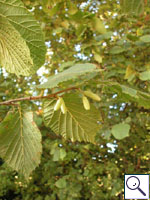 Hazel Corylus avellana |
|
Key for the identification of the known mines of British |
1a > Leaf-miner and case-bearer: The larva lives outside the mine, protected by a case, and feeds on the underlying plant tissues via a hole cut in the epidermis. From that point it eats away as much leaf tissue as it can reach without fully entering the mine. Mine does not contain frass (Coleophora species) |
1b > Leaf-miner, but not a case-bearer: The larva lives mainly inside the mine. Mine usually contains frass. In later instars the larva may live sandwiched between two more or less circular sections cut from the leaf. |
2a > Leaf-miner and case-bearer: The early case is tiny and the larva makes a series of tiny holes on the leaf. After overwintering it makes a shiny pistol shaped case in spring and window feeds. The young larva, before hibernation, makes tiny mines, sometimes tens in one leaf. After hibernation window feeding is done. In this latter stage the larva lives in a shining black pistol case of about 7 mm, that, with a mouth angle of 70°-80°, stands almost perpendicular on the leaf. |
|
Coleophora anatipenella (Hübner, 1796) [Lepidoptera: Bucculatricidae]. |
2b > Leaf-miner and case-bearer: The larva initially forms a gallery along the midrib, which then goes out along a vein. The end of this gallery is then excised to construct the first case. It then feeds close to this and makes several small mines. The final case is a small, laterally compressed, squat, spatulate leaf case of 5-6 mm. The dorsal keel has some serrations, remnants of the leaf margin out of which the case was cut. The rear is twovalved, and remarkably broad. The mouth angle is 0-10°. The description and illustration of the final case in Emmet et al. (1996a) is not quite clear. They depict a rather slender case, and state that the mouth angle is 30°. But, as the only illustration in the other literature that would agree with the British badiipennella, they refer to Hering (1957a, fig. 701): this illustration, however, has no resemblance to their own figure, and has a mouth angle of c. 0°. Emmet et al. write that the larva begins its life by making a gallery of 10-15 mm that runs from the midrib along a side vein; out if this mine the first youth case is excised. |
|
Coleophora badiipennella (Duponchel, 1843) [Lepidoptera: Coleophoridae]. |
2c > Leaf-miner and case-bearer: Larva mines leaves. The case is enlarged several times by mining a leaf-edge and inserting the existing case into the mine which is joined with silk. The final case is 7-8 mm long. Larva in a composite leaf case, composed of large leaf fragments. Characteristically, the leaf fragments are attached in a failry untidy way. In spring the case has two colours, because the old material (dull yellowish, grey or pink) dates from before the hibernation, while new, reddish brown material dates from after the winter. The case finally is about 7-8 mm long; the mouth angle is 40-45°.. |
|
Coleophora binderella (Kollar, 1832) [Lepidoptera: Coleophoridae]. |
2d > Leaf-miner and case-bearer: The full grown larva lives in a dull black pistol case of c 9 mm that, with a mouth angle of 80-90° stands erect on the leaf. Characteristic is the presence of some ear-like flaps. At least after the hibernation the larvae do not mine any more, but rather cause skeleton feeding. |
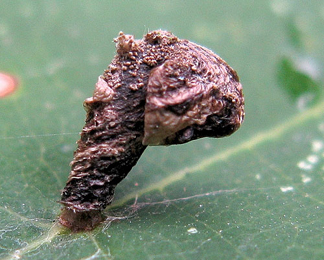 Case of Coleophora currucipennella on Quercus rubra Image: © Paul van Wielink (Bladmineerders van Europa) |
|
Coleophora currucipennella Zeller, 1839 [Lepidoptera: Coleophoridae]. |
2e > Leaf-miner and case-bearer: Lobe case. Many small leaf fragments are attached to the tubular case; its end is strongly curved downwards. The larvae are attached to the leaf underside, where they make a large number of relatively small full depth mines. |
|
Coleophora fuscocuprella Herrich-Schäffer, 1855 [Lepidoptera: Coleophoridae]. |
2f > Leaf-miner and case-bearer: Larva mining leaves, the blotches brownish. The final case is 8-11 mm long, slender, and fixed at 45° to leaf surface, with anal end laterally compressed. The case has a serrated keel due to formation from the edge of a leaf. Spatulate leaf case. Strikingly slender, bivalved case, 8-11 mm long, with a slight curve at the rear end, that is keeled and often toothed. The end is laterally compressed. Mouth angle 45°. The full depth mines often are conspicuously brown. |
|
Coleophora milvipennis Zeller, 1839 [Lepidoptera: Coleophoridae]. |
2g > Leaf-miner and case-bearer: Composite leaf case. The material used to enlarge the case consists of large pieces of full depth mine, that are attached with such precision that they may seem seemless. In the course of summer an autumn two (sometimes three, according to Hering, 1927b) pieces are added. No more material is added after hibernation, causing the case in spring to be rather uniformly coloured (contrary to C. binderella, that does add an extension in spring, and is made of fresh leaf material). |
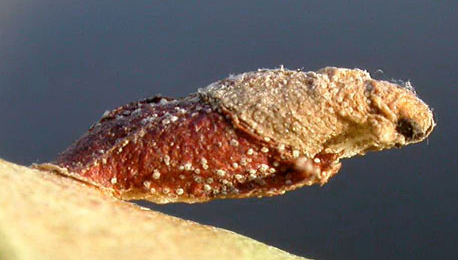 Case of Coleophora orbitella on Betula pendula Image: © Willem Ellis (Bladmineerders van Europa) |
|
Coleophora orbitella Zeller, 1849 [Lepidoptera: Coleophoridae]. |
2h > Leaf-miner and case-bearer: The larva feeds by inserting its head into small mines it creates on the leaves of birch, elm, alder, or hazel. Occasionally it is found feeding on other trees, or on herbaceous plants onto which it has accidentally Fallén. It forms two cases during its larval life. The first case is initially curved, smooth, laterally compressed with a bivalved anal opening, and about 2 mm long in September. During October it feeds, and adds a few rough collars of larval material around the oral opening. After hibernation, it feeds again in April and early May, adding more protruding collars until they equal or exceed the original smooth part of the case. At the same time, it expands the case girth by the creation of a silk gusset ventrally. The second case, 6 or 7 mm long, is formed in May, leaving the vacated first case attached to its last feeding mine. The new case is tubular with a trivalved crimp at the anal opening. The dorsum is formed from the edge of the leaf from which the case was cut. This results in a more or less serrated dorsal keel, depending on the plant species and the individual piece of leaf used. Considerable variation in the degree of serration can be found, even among specimens off the same tree. The case colour varies with food plant, from yellowish brown on birch, darkening through elm and hazel to dark brown on alder. The strongly curved young case is is a composite leaf case, the adult case is a tubular leaf case. The adult case is bivalved, about 7 mm in length; the mouth angle is around 30°. The case is straw coloured and almost always has a toothed dorsal keel (remnant of the margin of the leaf from which the case was cut). Neither larvae or cases of C. coracipennella, prunifoliae, serratella and spinella can be separated; from serratella. |
|
Coleophora serratella (Linnaeus, 1761) [Lepidoptera: Coleophoridae]. |
2i > Leaf-miner and case-bearer: The larva feeds on a wide range of trees, shrubs and herbs, favouring Rosaceae, but not exclusively. The fully developed cased larva may be found active in October and again, after winter diapause, in April. Cases, about 6 mm, of diapausing larvae may be found through winter, fixed to a tree or fence post. The dorsal surface of the case is usually covered in leaf fragments, but they can sometimes be worn off almost smooth. The ventral surface is swollen at the middle and has a keel, which usually bends upwards at the posterior. The cases of C. ahenella (on Rhamnus, Frangula, Viburnum and Cornus) and C. potentillae (case less swollen, keel not bent up, resting position less prone) are very similar. Brownish lobe case that lies almost flat on the leaf, either on the upper or on the lower side. Case widest about the middle. Ventrally there is a distinct keel. Mouth angle 0°. Full depth mines rather large. The flaps of cuticular tissue that serve to enlarge the case are cut out of the upper epidermis. (contrary to C. ahenella and C. potentillae, that use tissue from the lower epidermis). The removal of these tissue flaps creates holes that are much larger than those that serve as the entrance to the mine. |
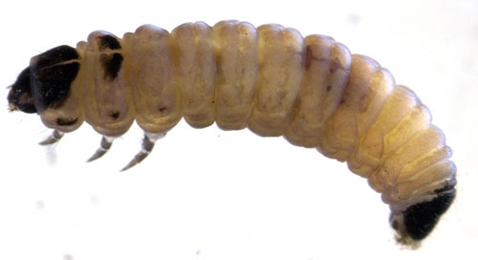 Coleophora violacea larva, lateral Image: © Willem Ellis (Bladmineerders van Europa) |
|
Coleophora violacea (Ström, 1783) [Lepidoptera: Coleophoridae]. |
3a > Leaf-miner: The larva begins with a short, full depth corridor, often along the midrib or a thick vein. Most of the mine with a thick frass line. The larva soon leaves the mine, and starts causing window-feeding, later eating holes in the leaf. The larval chamber (the space occuped by the larva, while in the mine, obviously free of frass) is more than three times as long as wide. |
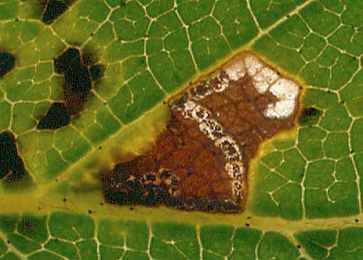 Mine of Bucculatrix demaryella on Betula pubscens Image: © Willem Ellis (Bladmineerders van Europa) |
|
Bucculatrix demaryella (Duponchel, 1840) [Lepidoptera: Bucculatricidae]. |
3b > Leaf-miner: The mine begins as a contorted gallery, when the young larva can be seen to have dark plates on each segment. These plates are later lost and the gallery becomes a blotch with scattered frass. Mine begins at a globular, black, lower-surface egg shell. From there starts a short tortuous corridor, that widens into a blotch, often between to lateral veins. Frass dispersed. Pupation outside the mine. |
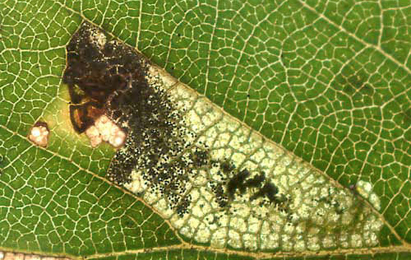 Mine of Ectoedemia minimella on Betula pubescens Image: © Willem Ellis (Bladmineerders van Europa) |
|
Ectoedemia minimella (Zetterstedt, 1839) [Lepidoptera: Nepticulidae]. |
3c > ? Leaf-miner: The larvae feed on a range of deciduous trees, windowing leaves in autumn and eating the buds, catkins, young shoots and then spun leaves in the spring. Cocoon formed in soil or where the larva fed British leafminers. |
|
|
|
Gypsonoma dealbana (Frölich, 1828) [Lepidoptera: Tortricidae]. |
3d > Leaf-miner: The larvae mine leaves at first, forming a blotch mine, later descending to the ground in a portable case and feeding on dead leaves. Oviposition is by way of an ovipositor, therefore no egg shell visible. The larva makes a small, roundish, blotch; often several in a leaf. Already after its first moult it makes an excision out of the mine, in size almost equal to the blotch (3-4 mm). Thus sandwiched it drops to the ground and continues feeding on dead leaf material. |
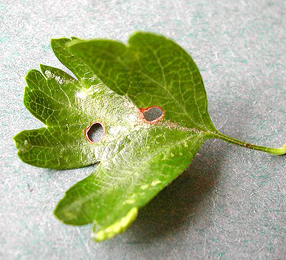 Mines of Incurvaria masculella Image: © Rob Edmunds (British leafminers) |
|
Incurvaria masculella (Denis & Schiffermüller, 1775) [Lepidoptera: Incurvariidae]. |
| 3e > Leaf-miner: The larva starts making a corridor of a few mm, followed, and mostly overrun, by a circular blotch of 4-5 mm diameter. Generally several larvae feed in a single leaf, creating a distinctive pattern of feeding windows. The larvae then cut out circular cases and drop to the leaf-litter to continue feeding, leaving behind a leaf containing many circular or oval cut-outs. |
|
Incurvaria pectinea Haworth 1828 [Lepidoptera: Incurvariidae]. |
3f > Leaf-miner: A gallery along the edge of the leaf leading to a circular blotch, from which a case is cut leaving a round hole (British leafminers, as O. signifer). Rather short corridor along the leaf margin, widening into a circular blotch that usually is free from the margin. The mature larva makes an excision that includes almost all of the blotch, and thus sandwidched drops to the ground for pupation. |
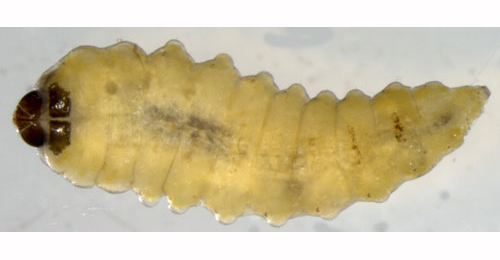 Orchestes avellanae larva, dorsal Image: © Willem Ellis (Bladmineerders van Europa) |
|
Orchestes avellanae (Donovan 1797) [Coleoptera: Curculionidae]. |
3g > Leaf-miner: The larva feeds on hazel or hornbeam, creating blotches with intertwining threads of frass, typical of the genus. Large white blotch, starting at the leaf margin. Frass in long threads. Often several larvae in a mine. Pupation outside the mine. |
|
Eriocrania chrysolepidella (Zeller, 1851) [Lepidoptera: Eriocraniidae]. |
3h > Leaf-miner: Early mine a squarish or triangular blotch with brownish lower epidermis. Thereafter two or three successive folds formed by folding the leaf margin upwards. Small, rectangular mine between two side veins (triangular when in a vein axil). The lower epidermis is brown. The larva begins feeding in the spongy parenchyma. Later also the palissade parenchyma along the outline of the mine is consumed. Finally all palissade parenchyma is eaten away, and the mine has become full depth and very transparant. Most frass in a cormer of the mine. After leaving the mine the larva lives in a rolled leaf margin. Here also pupation takes place. |
|
Parornix devoniella (Stainton, 1850) [Lepidoptera: Gracillariidae]. |
3i > Leaf-miner: The mine is upper side, over veins. Silvery, with brown speckling, later contracting to cause leaf to fold upwards. There may be several mines on each leaf. Upper-surface silvery tentiform mine. For some time the mine remains quite flat, and appears as a blotch mine. In the final stage the leaf is strongly contracted, however. Not infrequently several mines in a leaf. Pupa in a cocoon in a corner of the mine, frass heaped in the opposite corner. |
|
Phyllonorycter coryli (Nicelli, 1851) [Lepidoptera: Gracillariidae]. |
3j > Leaf-miner: The mine is 15-20 mm long with several creases in lower epidermis. It is lower side, strongly arched; a central green patch with brown flecks around edges. Lower-surface tentiform mine, usually between two side veins. Pupa in white cocoon in a corner of the mine, attached to both the roof and the floor of the mine; frass heaped in opposite corner. |
|
Phyllonorycter nicellii (Stainton, 1851) [Lepidoptera: Gracillariidae]. |
3k > Leaf-miner: The young larva mines the leaves of its foodplant then hibernates. It will then mines leaves or flowerbuds, then blossom or leaves. Branched, sometimes stellate, brownish, very transparent, sometimes long corridor that contains no frass. All frass is ejected through a number of tiny openings that generally are close to a vein. Only the young larvae are miners. |
|
Recurvaria nanella (Denis & Schiffermüller, 1775) [Lepidoptera: Gelechiidae]. |
3l > Leaf-miner: The early gallery is filled with frass, later leaving clear margins. Like Stigmella microtheriella the larva feeds on hazel or hornbeam, and its mines are often found alongside that species in the same leaf. However the mines of S. floslactella are generally wider, less angular and contain more scattered frass than those of S. microtheriella. Oviposition at the underside of the leaf, in a vein axil. Mine a slender, gradually widening corridor; the last section is clearly wider than the larva. In the first section the vaguely delimited frass line almost fills the corridor. Later the frass lies in irregular arcs and clouds, filling about one third of the width of the corridor. The trajectory of the mine is not angular, independent of the leaf venation. Pupation external, exit slit in the upper epidermis. |
|
Stigmella floslactella (Haworth, 1828) [Lepidoptera: Nepticulidae]. |
3m > Leaf-miner: A narrow gallery, tending to follow veins of leaf. The early part with linear frass. Oviposition at the underside of the leaf, mostly close to a vein. The mine is a long, very slender corridor; even towards the end hardly wider than necessary to accomodate the growing larva. Frass in a narrow central line. The shape of the mine differs somewhat between the hostplants. In Carpinus the mine closely follows a heavy vein over a long distance; also the mine tends to be somewhat shorter and broader, and the frass often lies in a more diffuse line. The mines in Corylus are not so strictly defined by the venation and the frass line is narrower (Emmet, 1983a; Johansson ao, 1990a). Sometimes it is difficult to separate the mines from those of S. floslactella; an additional difference then is that even in the very first part of the corridor the frass of microtheriella lies in a narrow line, while the frass of floslactella seems to fill the entire corridor there. The pale golden larva lies venter-upwards in the mine. Sometimes there can be several larvae mining the same leaf. |
|
Stigmella microtheriella (Stainton, 1854) [Lepidoptera: Nepticulidae]. |
3n > Leaf-miner: Full depth corridor, beginning at the base of the midrib and very roughly following the leaf margin; all the while the corridor widens, until almost the entire leaf has been mined out. Frass, as coarse grains or thread fragments, in the centre of the mine. The larva pupates in the mine, in a globular cocoon made of secretion. |
|
Tachyerges pseudostigma (Tempère, 1982) [Coleoptera: Curculionidae]. |
3o > Leaf-miner: Oviposition in the base of the midrib, without giving rise to an oviposition scar. The larva initially bores inside the midrib. Later it leaves the midrib, forming a broad corridor in the blade, that widens into a blotch. Finally the larva pupates in a globular cocoon inside the mine. Because the mine develops at a time that the leaf is fully developed, mined leaves are not disfigured. |
|
Tachyerges stigma (Germar, 1821) [Coleoptera: Curculionidae]. |
3p > Leaf-miner: Full depth blotch, invariably beginning at the leaf tip or the tip of a leaf lobe or tooth. Oviposition site covered by a black, shining drop of hardened secretion. Frass generally in long threads, but sometimes in elongated granules. Pupation in the mine, not in a cocoon. |
|
Trachys minutus (Linnaeus, 1758) [Coleoptera: Buprestidae]. |
3q > Long corridor mine, without obvious relation with the leaf margin, with little frass and irregularly eaten out sides. The first part of the mine is full depth and makes a few close loops; the second part is upper-surface and considerably wider. Primary feedings lines often obvious. The larva is so broad that is completely fills the mine. No morphological differences are known between the larvae of S. rubidum and those of S. testaceum (Steinhausen, 1994a). The larva leaves the mine to pupate in the soil (the larva of testaceum hibernates in the mine.) Hering (1957a) suggests that the imagines are easily separated, but this is contradicted by Warchalowski (2003a). |
|
Sphaeroderma rubidum (Graells, 1858) [Coloeptera : Chrysomelidae] |
| Last updated 03-Jul-2019 Brian Pitkin | ||
